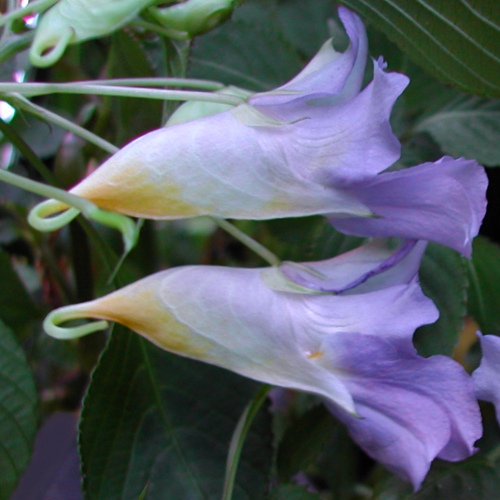| Home |
Strange Wonderful Things
Rare and exotic plants
|
 |
Impatiens sp. "Blue Angel"

Germinating the seeds
When to plant -- Plant your seeds when you receive them for best results.
Getting started -- You may plant each seed in individual, small containers,
such as
seedling starter trays . Or you
may plant them all in a single,
larger
container, but it may be difficult to separate the roots later. Either way, use
containers with drainage holes . Or you
may plant them all in a single,
larger
container, but it may be difficult to separate the roots later. Either way, use
containers with drainage holes
Use well-draining soil. A typical mix is 2 parts
quality potting soil to 1 part perlite
(small or medium size, not large chunks). to 1 part perlite
(small or medium size, not large chunks).
Fill the pots with soil and
place a seed or 2 on the surface.
If you have
long-fibered sphagnum moss , sprinkle
a small amount over the
surface. This helps retain
moisture around the seeds while allowing light to reach them, which aids
germination. The amount of moss to use is shown in
this photo.
If you don't have the moss, sprinkle a small amount of your soil mix around the
seeds. Then add water until everything is evenly moist (but not soggy). , sprinkle
a small amount over the
surface. This helps retain
moisture around the seeds while allowing light to reach them, which aids
germination. The amount of moss to use is shown in
this photo.
If you don't have the moss, sprinkle a small amount of your soil mix around the
seeds. Then add water until everything is evenly moist (but not soggy).
Until the seeds sprout, ensure that the surface soil always stays moist. A plastic dome or bag may be used to
maintain moisture, but leave it open slightly to allow some fresh air in. You may need to drip a few drops of water over the seeds every day
or two to keep the seeds
moist.
I recommend placing a
minimum/maximum thermometer near the pots. Until they sprout, try to
keep them between 60 to 78 degrees F (16-26°C)
during the day (but below 80°F / 27°C), with nights between 40-62° F (4-16°C).
If you can't give them that temperature range at night, put the pots in the
refrigerator for 6 weeks. Seal them in a container or bag first, and mark
your calendar to remove them. near the pots. Until they sprout, try to
keep them between 60 to 78 degrees F (16-26°C)
during the day (but below 80°F / 27°C), with nights between 40-62° F (4-16°C).
If you can't give them that temperature range at night, put the pots in the
refrigerator for 6 weeks. Seal them in a container or bag first, and mark
your calendar to remove them.
An LED bulb kept 4 inches (10 cm) away provides the right amount of
light (See: "Growing indoors with LED lights"). Protect from direct sun.
They should start germinating in about 4 to 6 weeks, and continue for about a month. For the first 3 weeks after sprouting, continue keeping the
soil surface moist. After that, you may remove any plastic dome.
Fertilizing -- When they are 2 weeks old, feed every 2-3 weeks with a small amount of
diluted liquid fertilizer (1/8 strength).
Hydroponic fertilizer is ideal for this, since it is easily absorbed and
complete. After 2 months, you may switch to a granular fertilizer that
contains micronutrients.
Growing onward...
Lighting -- This Impatiens prefers bright, filtered light. It will
need some protection from strong, direct sun, so watch for possible wilting in
sunlight.
Transplanting -- When your
plants are 2-3 months old, you may gently transfer them to larger pots.
Avoid damaging the roots when repotting, and shade it from sun the first week
after repotting. A 4 inch (10cm) pot can hold it for a few months, then
move it to a 1 gallon (4 liter) pot. The second year, use approximately a
2-3 gallon (8-12 liter) pot.
Watering -- Aim to keep the soil evenly moist, never letting it dry out completely,
except if it goes dormant in cool conditions. You may use a moisture meter probe to monitor the moisture levels down in the root zone.
Climate -- It prefers temperatures below 85° F (29°C), with nights below 65°F (18°C). In warmer climates,
keep the pot shaded. The rhizomes of mature plants should survive
down to at least 25° F (-4°C) if well mulched, but it's best to keep it above
freezing the first 2 years.
Over about
40% humidity is best. If it seems to suffer from low humidity indoors, consider using an ultrasonic room humidifier,
sold at
home improvement stores and some thrift shops.
Dormancy care -- In winter
the rhizomes may go dormant if conditions are cool enough. If this happens,
reduce watering, keeping the soil slightly moist until they sprout in spring. Indoors, the plant might not go dormant, or it may
go semi-dormant. Don't feed it while it's semi-dormant.
Pests to watch for -- Watch for any pests that can affect your other
plants.
Start with
insecticidal soap
spray before using stronger remedies.
Have fun growing them!
- Jeff
Strange Wonderful Things
| Home |
Strange Wonderful Things
Rare and exotic plants |

|
| Entire site Copyright 2003-2025 by Strange Wonderful Things, except as noted |
|


